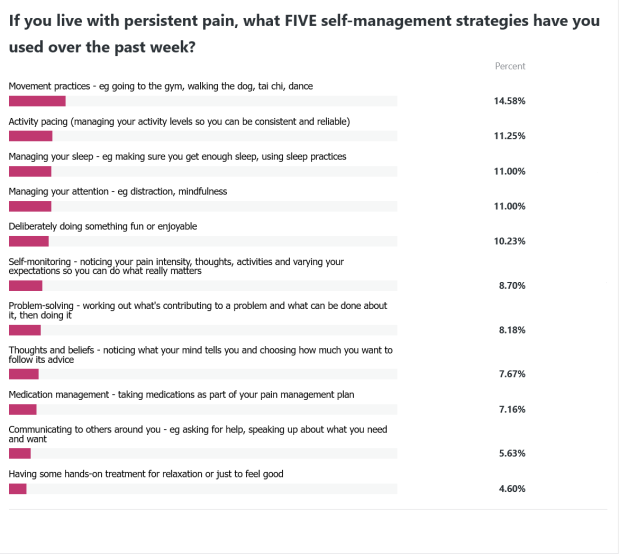No, I’m not going to assemble a bunch of papers and point out the effect sizes of exercise on pain and disability! In fact, I’m not even going to point to much research in this post. I want to pose some questions and put some thoughts out for discussion.
See, the people I’ve seen over the years who live with pain have, by and large, not been great ‘exercisers’ before their pain came on, and many haven’t really changed their lifestyle a heap since their pain either. In fact, there is research showing that people with chronic pain don’t change the overall quantity of their activity very much – but instead, change the pattern of that activity over the course of a day (Huijnen et al., . 2011; Tynan et al., 2023). Nevertheless, because of the influence of the ‘deactivation’ idea, along with the pain-related fear and avoidance model, and of course the benefits of exercise on other aspects of health, there would be very few people living with chronic pain who haven’t been prescribed some sort of exercise intervention.
I’ve made my views on exercise known many times – but once again, for the avoidance of doubt, I think movement is awesome, healthy, integral to living well and something to be done regularly and with enthusiasm. I’m less comfortable, however, with people being obligated to ‘do exercise’ with unhelpful explanations, the inflated promise of effects, and in forms that simply do not fit in with the complex lives we all live – now and over our lifespans.
Some of the unhelpful narratives include: that exercise will ‘take away the pain’; that exercise will improve functioning elsewhere in life; that symmetry is crucial; that core strengthening is needed; that ‘form’ must be ‘perfect’ (whatever that is); that progression should follow some formula (and not based on the person’s response to it); that one type of exercise is ‘the right one’; and that exercise must be supervised by a clinician or it doesn’t work. Bah humbug.
So. We do need to move and do that regularly. That’s a given. There are loads of ways to move and people who regularly meet the WHO exercise recommendations do this in a myriad of ways that look a lot like dance, walking, cycling, gardening, playing with the dogs and kids, leaping into the sea or a pool, doing housework, doing hobbies… all the things. Movement and life go together.
What does exercise offer people with pain?
Well, to me exercise is a simplified context for learning what feels OK and what doesn’t. Exercise (or movement practices) don’t have all the contextual factors that make life difficult. For example, when I’m gardening I need to factor in the ambient temperature, the time of year, the lifecycle of my plants, their needs for compost and water and pest removal. I also need to find a suitable time to garden, assemble all my equipment, be aware of all the other things I need to get done in my ‘spare’ time, and what needs doing in my garden. If I’m working alongside other people, I need to bear in mind the bits they want to do, the bits that need doing, and the bits I like to do. We need to coordinate our efforts so we don’t all go to do the same thing. Gardening is always influenced by context.
If, as I suspect, movement practices offer a simplified context to do movement with a person who helps me feel safe (I won’t damage myself when a therapist is present), who can encourage me to nudge in to movements I’m not confident about, who can offer suggestions about how I might change the way I go about doing a movement, or the quantity – then the ‘work’ is much less about the form of movement I do but much more about the ‘work’ the clinician does. And clinicians, it probably isn’t to do with the form or quality of my movements, but so much more about how YOU go about guiding ME to experience what my body is feeling like while it’s doing the things.
If my hunch is on the money, then the skills so often relegated to ‘oh you’d better do some communication stuff’ or ‘those soft skills’ might actually be the most critical ones a clinician can develop. Because, so it’s been found, words are sticky and have power (O’Keeffe et al., 2022) – and the more people listen to the words spoken in a clinical context, the less able they are to notice their own body responses (we can’t do divided attention very well). And those words spoken can act as life-long rules for behaviour (Barnes-Holmes & Harte, 2022). We know this simply by listening to the narratives of people describing no longer doing things they love on the basis of an authoritative word from a surgeon about the state of an osteoarthritic joint, or back pain and the risk of ‘damage’…(eg Stenberg et al., 2014; Christe et al., 2021).
What skills might be needed to facilitate awareness and build confidence?
Guided discovery is an approach used in psychotherapy – this involves the clinician obtaining data (information) from the person using open-ended questions, then guiding the person to pull that information together in surprising ways, testing assumptions and helping them to notice what they already know to be true. In therapies such as graded exposure for phobias, guided discovery helps people notice and be OK to nudge into discomfort, waiting for the symptoms of anxiety to reduce, and then noticing that this has happened even in the presence of the thing the person fears. From ACT, noticing without judgement is an integral process for people to tune in to sensory experiences so they can be in the present moment and become aware of the in-real-time impact of their actions.
I suspect the same skills might be critical for effectively guiding learning in movement therapies. That is, helping the person nudge into previously worrying movements, guiding them to notice what happens, remaining engaged in the movement enough times that the alertness level drops, and then drawing the person’s attention to how that feels. The therapists work is all about guiding the person to notice their own sensory experience, and of course, in structuring the movements so that the intensity and complexity suit where the person is at.
What this kind of approach won’t do on its own, is help that person transfer their learning undertaken in the safe clinic area with a safe clinician, into the complexity of daily life – and this is where occupational therapists should be adding their input. Because learning doesn’t transfer readily from one context to another without this process being structured, and without lots of repetition and exposure to lots of different contexts.
Helping people gain confidence in what their body feels like when it’s moving is a ‘transferable skill’. Learning to trust your own body experience allows you to experiment with different forms of movement practice. Different movement practices allow us to keep moving throughout our entire lives, in different ways to suit time, equipment, location, goals, money and motivation/interest.
You see, I don’t think movement or exercise is much about fitness or other physiological factors, except that when someone has a pain problem, it’s likely to mean a much bigger reaction from the nervous system (ie pain payback or pain flares) than in everyday folks. To counter this, we need to build confidence, awareness, willingness to go gently into these uncomfortable experiences, and then to sustain practice in all the life contexts so we can be able to do the things exercise and movement are supposed to promote: healthy living. If exercise doesn’t contribute to healthy living (note the emphasis on living), then all the health in the world isn’t worth it. If I’m healthy but don’t do the living I want to do, why that sounds a lot like being in prison.
Barnes-Holmes, D., & Harte, C. (2022). Relational frame theory 20 years on: The Odysseus voyage and beyond. Journal of the Experimental Analysis of Behavior, 117(2), 240-266. https://doi.org/10.1002/jeab.733
Christe, G., Pizzolato, V., Meyer, M., Nzamba, J., & Pichonnaz, C. (2021). Unhelpful beliefs and attitudes about low back pain in the general population: A cross-sectional survey. Musculoskelet Science and Practice, 52, 102342. https://doi.org/10.1016/j.msksp.2021.102342
Huijnen IP, Verbunt JA, Peters ML, et al. Differences in activity-related behaviour among patients with chronic low back pain. European Journal of Pain 15(7):748-755, 2011.
O’Keeffe, M., Ferreira, G. E., Harris, I. A., Darlow, B., Buchbinder, R., Traeger, A. C., Zadro, J. R., Herbert, R. D., Thomas, R., Belton, J., & Maher, C. G. (2022). Effect of diagnostic labelling on management intentions for non-specific low back pain: A randomized scenario-based experiment. Eur J Pain. https://doi.org/10.1002/ejp.1981
Stenberg, G., Fjellman-Wiklund, A., & Ahlgren, C. (2014). ‘I am afraid to make the damage worse’ – fear of engaging in physical activity among patients with neck or back pain – a gender perspective. Scandinavian Journal of Caring Sciences, 28(1), 146-154. https://doi.org/10.1111/scs.12043
Tynan, M., Virzi, N., Wooldridge, J. S., Morse, J. L., & Herbert, M. S. (2023). Examining the Association Between Objective Physical Activity and Momentary Pain: A Systematic Review of Studies Using Ambulatory Assessment. Journal of Pain. https://doi.org/10.1016/j.jpain.2023.10.021
Villatte, M., Villatte, J. L., & Hayes, S. C. (2016). Mastering the clinical conversation: Language as intervention. Guilford Press.












